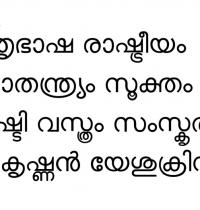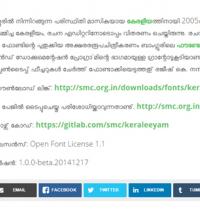KH Hussain
Grant Period: Over one year and six months
The grant supports Thrissur based researcher and designer KH Hussain to document and analyse the cultural, aesthetic, and technological paradigms alongside the political debates around the standardisation and modernisation of Malayalam script in the era of open source movements.
With a history of over 1600 years of evolution of a rich phonetic collection of the language and sign system for its inscription on various mediums, the complete set of Malayalam script evolved for printing in 19th century with the help of movable types - designed by Benjamin Bailey, a Jesuit priest. It retained its rich heritage in conformity with the fundamental structure of other Indian scripts and was adopted widely in printing. Bailey’s script was taught in schools in Kerala until as late as 1970 when a new script was introduced in the pretext of introduction of typewriters. Though typewriters were welcome, the adoption of this new script was seen as an act of assertion of power by the government that caused dissents. Further, the non-systematisation of this new script created tremendous confusion in the language and its learning process right from its inception. Attempts to solve the confusions created further chaos until the formation of Rachana Akshara Vedi Movement, which re-introduced the original character set in Malayalam computing. The movement designed the Rachana font and an editor package capable of creating all the traditional conjuncts followed by Meera Unicode font in 2006.
With the support of this grant, Hussain will reconstruct the historical continuities and disjunctions in the evolution of the Malayalam script and trace its history through the upheavals. Alongside, the research will also focus on the contribution of Benjamin Bailey and the process of standardisation of Malayalam types looking into the major shifts and structural changes that affected it at various stages. The researcher will document and analyse the debates that surrounded the script reform in the 1970s by focusing on the concerns and ideological contexts of the agencies which were instrumental in the modernisation of the script, while at the same time studying the articulations of resistance against this process. The advantages and disadvantages of modernisation will also be discussed with their impacts on the aesthetics of Malayalam calligraphy in the field of artistic expression and commercial art in the public domain.
In order to analyse the changes that occurred due to script modernisation, Hussain will collect the samples of types and fonts of Malayalam script of various periods from book covers, wall writings, hoardings, banners, and movie posters; and study the scholarly articles and papers on modernisation of the script written during the past forty years. He will also probe into the modern theories on visuality and visual experiences that shaped the aesthetics and culture of written expression.
The outcome of this grant will be a comprehensive website archiving documents, articles, paper clippings, pictures, photographs, audio-visual clippings etc. Apart from this, Hussain will compile a book in Malayalam on the history and evolution of the Malayalam lipi consisting of articles by scholars and interviews with the people who have been part of the Malayalam language reformation movement in various capacities. The content of the book will be elaborated with illustrations and examples. A font of the original Malayalam script will be also designed and published for free, acknowledging IFA.
The decision to support this grant comes out of IFA’s interest in supporting marginalised or relatively unexplored areas of concern, both historical and contemporary, in languages other than English. This project will surely be a landmark work documenting the hitherto unchartered history of the evolution of the Malayalam script.
This grant was made possible with support from the Bajaj Group.





